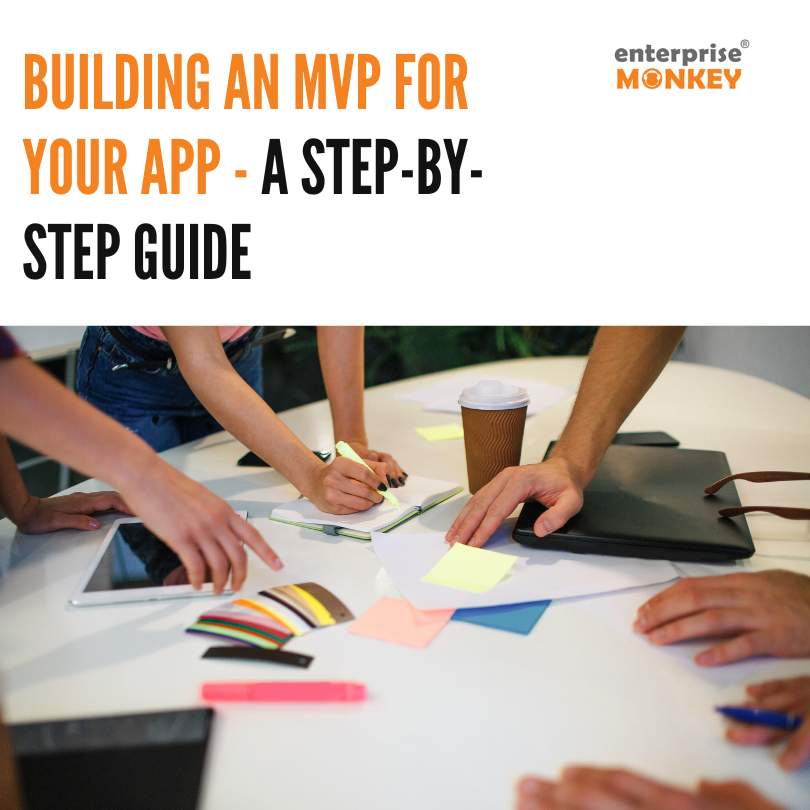A successful business demands a top-notch mobile app, yet creating one requires significant expertise and investment. Users nowadays won’t tolerate any glitches and readily abandon apps that fall short of expectations.
Determining if you’re on the right track can be gauged through an MVP, or the initial basic version of your mobile app. So, the first thing you need to know is how to build an MVP for your mobile application.
 [Source: Business of Apps]
[Source: Business of Apps]
Creating a Minimum Viable Product (MVP) fosters a step towards success. An MVP helps you test your actual product (final application) by creating a prototype with just essential features for early consumers.
Your potential customers can use the MVP version of your app and provide you with organic feedback. You can also test the app’s concept and minimise the risks associated with the direct market release of your final product. This low-cost, and effort option will assist you in making an informed decision without investing excessive time and resources.
So, now that you understand the importance of building an MVP for your app let’s understand its development process in detail. We will also explore the various benefits of MVP for your business and the mistakes you must avoid while creating a minimum viable product. But first, let’s begin with the introduction of the MVP for your application.
What is MVP for a mobile application?
MVP (Minimum Viable Product) here refers to the initial version of a mobile application that includes only its essential features and functionalities. The main objective of developing an MVP (Minimum Viable Product) in mobile app development is to introduce the most essential features of your app to your target customer. This approach allows you to collect user feedback and validate the core concept or idea behind the app.
MVPs are commonly used during the process of mobile app development, especially in a startup environment, where resources may be limited, and there’s a need to demonstrate an app’s viability before seeking additional funding or undertaking a full-scale development effort. As the MVP evolves and matures, it can be a foundation for developing a more feature-rich and polished mobile app.
| Do You Know!
Facebook, as we know it today, was started as a universal directory for Harvard students by Mark Zuckerberg. In its MVP stage, known as Thefacebook, it included only essential features and was accessible to a limited number of users or early adopters. Now, Facebook is one of the most popular social media networking sites, catering to 1.3 billion monthly active users worldwide.
[Source: ClearCode] |
Many companies use the Agile development methodology in the MVP concept to efficiently observe their mobile application’s development. Let’s find out more about the MVP Agile concept in brief below:
What is MVP Agile?
“MVP Agile” in mobile app development combines two key concepts: Minimum Viable Product (MVP) and Agile methodology. This approach integrates Agile development methodology with the MVP strategy to build and iterate upon mobile apps efficiently.
MVP Agile development involves creating an initial version of the mobile app (the MVP) with the most critical features. However, instead of stopping there, it leverages Agile principles to work in short development cycles or sprints.
After the MVP launch, the development team refines the app by adding features, enhancing user experience, and resolving issues in subsequent sprints, guided by user feedback. This approach ensures the app evolves to meet changing requirements while remaining user-focused.

Advantages of MVP
Creating an MVP in the mobile app development process offers numerous advantages. It helps in the reduction of development costs and efforts, creates focus on user needs and, helps in validating your app concept. It’s a strategic approach that can lead to more successful, user-centric, and cost-effective app development.
The following are the key advantages of adopting the MVP approach to your mobile app-building process:
- Faster Time to Market – Developing an MVP focuses on creating a simplified app version with only essential features. This means you can launch the app more quickly, allowing you to start serving your target audience and gaining valuable user insights sooner.
- Cost Efficiency – By building a minimal app version, you save money on development costs. This approach helps you avoid investing in extensive features that may not be necessary.
- Market Validation – An MVP lets you test your app’s concept and demand in the real world. User’s generic feedback and data gathered from the MVP can help you determine if your app idea is viable, ensuring you’re not investing in a product with little, or no market interest.
- User-Centric Design – Early user feedback is invaluable. With an MVP, you can gather user input and insights, allowing you to make informed decisions about further development. This helps ensure that the app is tailored to your business requirements and the preferences of your target audience.
- Iterative Improvement – MVPs facilitate an iterative development process. You can use feedback to refine and enhance your app, addressing issues and adding features based on user needs and preferences.
- Reduced Risk – Starting with an MVP minimises the risk associated with large-scale development. If your MVP proves unsuccessful, you can pivot, modify your approach, or abandon the project without significant resource loss.
- Proof of Concept – MVP serves as a proof of concept. It demonstrates to investors, stakeholders, and potential users that your idea has potential and is worth further development.
How to Build a Minimum Viable Product (MVP)?
Now that you know the concept of MVP and its various benefits, it’s time to have a thorough knowledge of its building process.
Building a Minimum Viable Product (MVP) is a strategic process that involves the creation of a simplified version of your actual app with the core features and functionalities.

Below is a six step guide to building an MVP for your company:
Step 1: Goal Identification and Market Research
The first essential step of MVP development is identifying the goal behind its creation. For this, you must clearly define the purpose and vision of your mobile app and identify the problem your app aims to solve or the need it addresses. You must set specific goals and objectives for your MVP.
| Data showing various reasons for the failure of mobile application. The major reason is captured as lack of proper market research by developers before building the app.
|
Market research serves as a basis for the validation of your idea. A lack of proper consumer research may even lead to the failure of your application. Therefore, thoroughly research your target audience, competitors, and the niche market before going ahead with the building process of MVP.
After this, validate the demand for your app idea by identifying user pain points and assessing competition. The purpose of this step is to ensure there is a market for your app before proceeding.
Step 2: Prioritise Features, Design and Prototype
Next is the listing of all the features you envision for your app. You must think this will be your final product and then prioritise features based on their importance and relevance to your app’s core functionality.
Use the market research data and map your targeted audience journey on your MVP to cater to their pain points. Select only the essential features that are crucial for your MVP.
 [Source: Future Processing]
[Source: Future Processing]
After this, create wireframes or sketches of your app’s user interface (UI) and develop a low-fidelity prototype to visualise the user flow and design. You must focus on the user experience and user interface (UX/UI) design to attain maximum attention.
Step 3: Development of MVP
Now, the most crucial step is to start with the actual development process of your MVP. Begin by building the app’s core features as defined in the prioritisation phase. Emphasise the simplicity and efficiency in coding to reduce development time.
At no point in time should you compromise with the quality. Built it like a final product, ensuring a smooth user journey and experience.
| They All Started with MVP!
Most of the giants we know today started with MVP to evaluate the user’s feedback and pain points. Uber, Instagram, Facebook, Twitter, Amazon, LinkedIn, Spotify, Airbnb, Dropbox, Groupon, and Zappos are to name some. |
Another essential step during the development of MVP is to decide whether to develop your app in-house, outsource development to a third party, or use a low-code/no-code platform.
Since MVP will provide you with the critical data for your final mobile application, you can hire a competent and expert third-party app developer based on your requirements. Your team’s core work is to create a functional MVP by selecting the development tools, languages, and platforms that best suit your needs.
Step 4: Quality Assurance Test and User Feedback Collection
After completing your MVP building process, it’s time to thoroughly test the product for functionality, performance, and usability. Initiate the tests to identify and fix bugs, issues, or problems to ensure a stable and reliable user experience.
Once the QA tests start giving satisfying results, launch your MVP to a limited group of users or beta testers. Gather their feedback on the app’s usability, features, and overall experience and encourage them to report issues and provide suggestions.

Step 5: Launch and Deployment
Based on user feedback, iterate on your MVP. Address all the identified issues, refine the user interface, improve the user experience accordingly and continue to make enhancements in subsequent iterations.
Once you are satisfied with the iteration and improvements, prepare for an official launch of your MVP. Based on the stability and positive feedback, submit your app to app stores (e.g., Apple App Store, Google Play Store) and make it available to a broader audience.
Step 6: Monitor and Analyse
You have launched your MVP app, and now it’s time to execute the marketing and promotional strategies as planned. Work on attracting users and growing your user base. To gain the maximum traction, leverage early user reviews and testimonials.
Keep monitoring your app’s performance and user engagement data closely and continuously. Your development team must use analytics tools to collect user data, gain insights into user behaviour and make data-driven decisions for future development.
As your app gains users and positive feedback, consider expanding its features and functionalities based on user needs and market trends.
| Example Set by Instagram!
Instagram today was originally Burbn when it launched its MVP product in 2010. Burbn was created by Kevin Systrom and Mike Krieger with an idea to let the users login and share their experiences at various locations with friends and family. The concept was a massive hit, with 25,000 users signing up overnight. However, users felt difficulties using some of the app’s features and functionalities, which were later removed by the company. They made the core features of photo sharing, liking and commenting more simple and relaunched the final product with the name Instagram. Instagram now dominates the social media market with 1 billion monthly active users worldwide, with 500 million stories created daily. Instagram set an example by working on the basic rule of MVP, i.e. build, measure, learn and repeat the cycle. |
6 Major Development Mistakes to Avoid While Building MVP
Building an MVP (Minimum Viable Product) for mobile app development is a crucial phase, and it’s not uncommon for developers to make mistakes during this process. These mistakes can lead to delays, increased costs, and hinder the app’s success.
The six major development mistakes to avoid during MVP development for mobile app design are:
1. Features Overloaded
Including too many features in the MVP is a common mistake because it contradicts the essence of creating an MVP. The primary purpose of an MVP is to develop a minimal, streamlined version of your product that serves as a starting point for testing and validation.
Adding too many features to the MVP can make the development process overly complex and time-consuming, and gathering specific user feedback and insights on individual components becomes challenging.
Solution:
Focus on the most critical features that address the core problem or need your app is designed to solve. Be strict about prioritisation.
2. Ignoring User Feedback
MVPs are designed to address real user needs and problems. Ignoring user feedback means you’re missing the opportunity to make user-driven decisions, resulting in a product that may not align with user expectations.
User feedback is essential for this validation process, and ignoring them can lead to building an app that doesn’t resonate with the target audience.
Solution:
Continuously engage with users, gather feedback, and adjust the MVP based on their insights. User feedback is invaluable in shaping your app.
3. Poor UI/UX Design
The UI/UX is often the first aspect of the app that users encounter. Poor design can lead to a negative first impression, discouraging users from further exploring the app.
Poor design can result in users struggling to figure out how to use the app effectively, leading to high abandonment rates and low user retention.
 [Source: LinkedIn]
[Source: LinkedIn]
Solution:
Ensure that the MVP offers an intuitive and user-friendly design. Invest in creating a visually appealing and functional UI/UX that meets user expectations.
[Also Read: Importance of UI/UX Design in an App Development Process]
4. Inadequate Testing
Inadequate testing can result in undetected bugs, glitches, and technical issues in the app. These issues can lead to crashes, slow loading times, or unresponsiveness, resulting in poor user experience and may disorient and discourage users from using the app.
Testing on various devices, screen sizes, and operating systems is equally important to ensure the app works well for all users. Inadequate testing may result in compatibility issues, limiting your app’s audience.
Solution:
Thoroughly test the MVP for functionality, performance, and compatibility across different devices and platforms. Address all identified issues before release.
[Also Read: Conduct User Testing for Mobile Application in 5 Easy Ways]
5. Failure to Define Clear Objective
Without clear objectives, the development team may lack a clear focus on what the MVP aims to achieve. This can lead to feature creep, a lack of direction, and a diluted product.
With the unclear plan, you might struggle to identify what’s most important for the initial release, making it challenging to determine whether the MVP fulfils its purpose.
Solution:
Clearly define what you aim to achieve with your MVP. Set specific objectives and metrics to measure its success. This clarity will guide the development and evaluation process.
6. Underestimating Development Time and Resources
Underestimating development time can result in project delays, allowing competitors to launch similar products before you do, potentially eroding your market advantage.
Rushed development often leads to inefficiencies, rework, and increased costs to fix errors and address shortcomings in the MVP. You may observe the compromised MVP quality when developers start cutting corners, leading to lower code quality, more bugs, reduced performance, and poor user experiences.
Solution:
Realistically assess the development timeline and resource needs. Factor in potential delays and allocate sufficient resources to complete the MVP.
Conclusion
The MVP approach not only reduces risks but also paves the way for ongoing improvements, ensuring your app’s growth and success in the competitive world of mobile app development.
This complete guide will prepare you to create a successful MVP for your app and take the first steps toward turning your vision into a reality. However, if you are more of a businessperson and require technical assistance in developing a strategic approach towards MVP building process, a professional mobile app development agency can serve as your strategic partner.
Our highly expert developers and seasoned professionals will not only help you build an MVP, but also provide you thorough guidance required to gather relevant data to foster the actual product.







 [Source:
[Source: 






